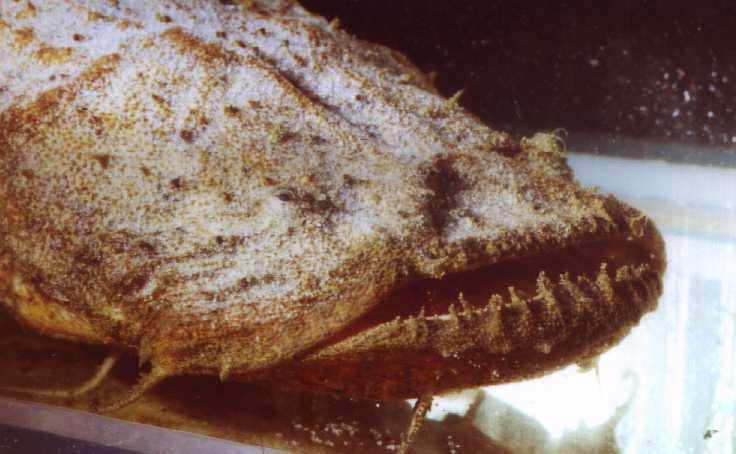If there’s any catfish that could live
up to my wildest conception of an all-devouring monster secretly lurking in the
ground, would have to be that Frogmouth Chaca chaca!
30.12 2000
I saw one today which,
without permission so-to-speak, had eaten two little Astronotus ocellatus over night
and looked accordingly bloated. It must have been 20 cm long already and had a rather
broad mouth armed with lots of small sharp teeth.
I can hardly resist
the fascination this animal exerts on me and have since been wondering whether I
could put it into one of these tanks and, if so, which one of them I should use.
I couldn’t put it into a community tank, of course. It would need to be a single-species
tank or, at the most, one which has only a few large fishes which would not arouse
its suspicion.
The problem, to me,
seems to be what it eats – I’m not sure whether I’ll be able and willing to supply
sufficient food, i.e. live fish or not.
The literature suggests that only young Chaca chacas eat worms etc.
But anyway, I can’t think about anything else but this catfish anymore!
31.12.
I‘ ve now got a free tank with sand for the predator!
2.1.2001
I’ve got it!
It let me transfer
it without showing any resistance – almost like the banjo catfish – only growling
rather unfriendly in the course of the procedure (see next photo)
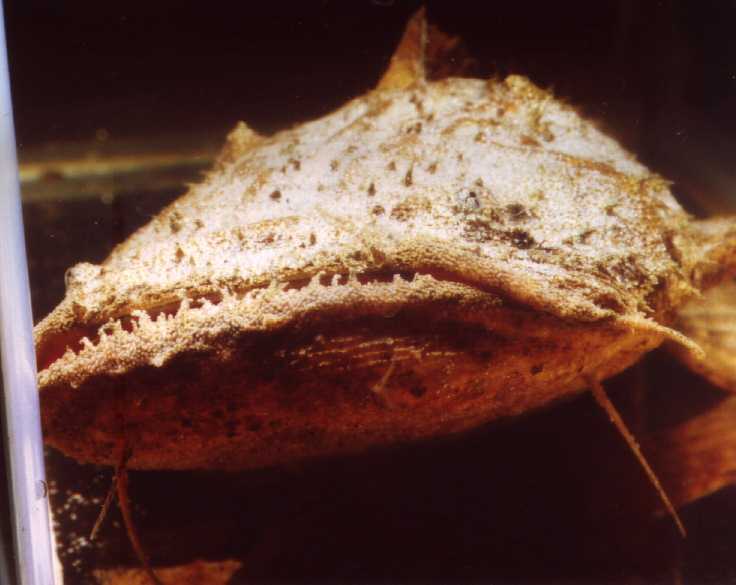
During the drive in
the car – it was sitting in a bucket – it swam back and forth constantly and growled
while doing so. When we arrived at home I put it into a photo tank first of all
for it to be able to acclimatize and took a lot of pictures....
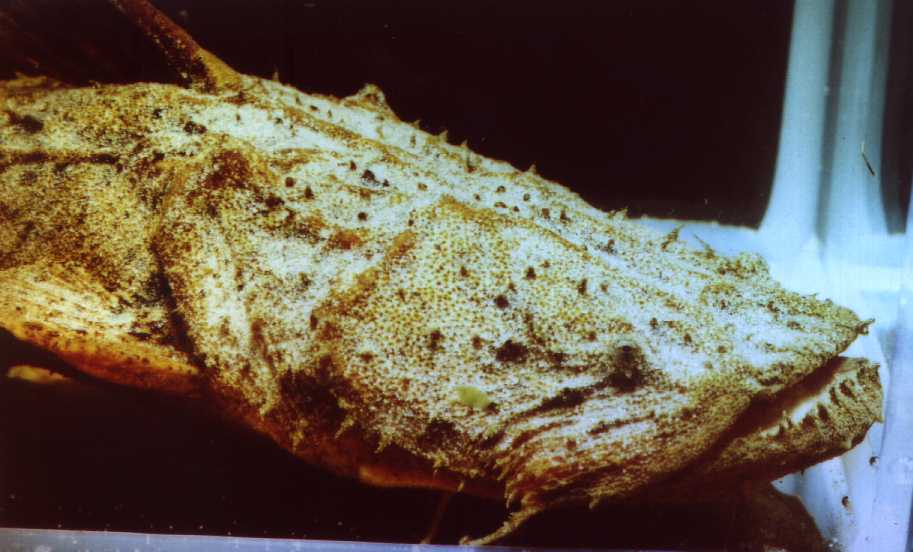
My Chaca chaca seems
to be fully-grown, it must be a good 20 cm from the tip of its mouth to the end
of its tail-fin – almost half of this is head and mouth. The mouth consists of a
rather broad slit which, at the same time, represents nearly the broadest part of
the body.
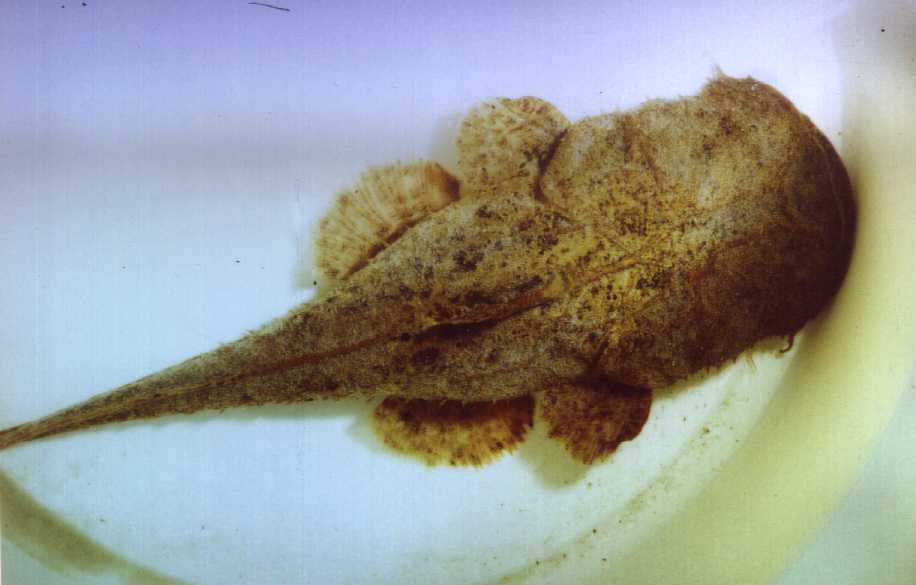
It was very calm during
the entire photo session, only occasionally turned around in the tank. It is excellently
camouflaged, if you think that it is buried in the ground most of the time. The
eyes are extremely tiny in relation to the rest of its body and located quite far
at the front on the sides of the upper jaw. Transferring it to its proper tank was
also very easy – I only had a small fishing net at hand which it only just fitted
into with the front of its body – but not a problem! It stayed calm and didn’t wriggle
or slap around, as almost any other fish would do in that situation.
It is now sharing a 100x30x30er tank
with a small P. gibbiceps which, however, is large enough not to be identified as
prey by the Chaca.
The tank is equipped with sand and a large piece of Scottish bog oak.
First of all it inspected
the entire tank, of course, which took around thirty minutes, then it vigorously
dug itself into the sand with its broad mouth and no longer could be seen.
The scanty literature
on Chaca chacas states a preferred temperature of up to 24° C and the fact that
these catfishes can perfectly well be accustomed to other types of food and even
to food tablets.
It ate something!
In a pet shop, I got myself ten smaller Tilapia cheap, each about 5-6 cm long (finding
bait or feeder fish here in winter turned out not o be so easy after all!)
I put the Tilapia into the Chaca tank – it was nowhere to be seen - and the Tilapia
decided first of all to form a shoal and explore the tank. A large piece of Scottish
bog oak on the left with a P. gibbiceps on it and a large, deserted sand area on
the right - deserted???
Not even I was able
to detect the buried Chaca straight away, it had completely disappeared under the
ground, but that was to change soon.
I had some feeding
and changing of water to do and kept an eye on the Chaca tank while doing so.
In the meantime, a small dent had formed in the beige sand, and if you had a closer
look you even noticed an occasional breathing of this dent.
The shoal of Tilapia
was still thoroughly examining the tank, intook something into their mouths here
and there, expelled it again and carried on in that way for about half an hour.
While picking around on the sandy ground the shoal would get dangerously close to
the dent in the sand, would swim away and back again – suddenly the catfish opened
its large mouth – large cloud of sand – MISSED!
- instantly all the
Tilapia were to be found behind the root on the left.
Now, I didn’t know
whether Tilapia learn from experience. However, I did find out soon that their curiosity
(or forgetfulness?) might be stronger
I had a close look
at the Chaca dent with the magnifying glass. It was really a breathing dent in the
sand with two little black grains of sand that were observing everything very carefully.
All you could see was
this broad slit of a (closed) mouth and part of the front upper jaw – the upper
lip. It looked well-camouflaged and not at all suspect.
Only occasionally a nervous tremble ran over the upper lip. The tip of the mouth
looked like a dark line in the light-coloured sand. However, this dark line, together
with the occasional light twitches of the upper lip did arouse the Tilapias’ attention
when they were busy in the area.
Another sudden snap – missed again!
The Tilapia have formed
a shoal in the middle of the tank, as though to withdraw for discussion, then back
to the bog wood.
At its third attempt
it did get one, though – no more camouflaged dent in the sand after that, now the
entire front part of the Chaca’s body rose to an upright position and the huge mouth
chewed around on something several times, then a tail fin appeared and disappeared
again.
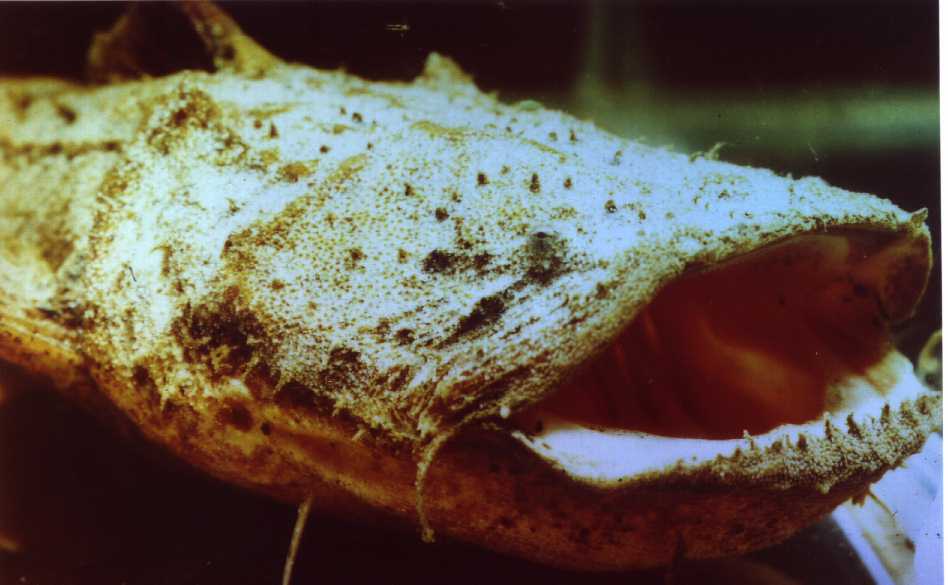
So the catfish turns
its prey around in the mouth, so that it can swallow it with the head first. It
thus prevents any of its prey’s rays of the fin from projecting sideways or spikes
from getting caught, just as pikes or snakes do.
Concerning the Tilapia, I’d really
like to know whether or not they have registered that there are only nine of them
now. In how far can they build up a concept of the enemy and escape although the
enemy cannot be seen all the time?
At night, before the
light went out, there were only eight Tilapia left.
13.1.
Meanwhile there are only seven Tilapia dwelling in the Chaca territory. On the one
hand, it looks as though the Chaca’s appetite is still satisfied – it’s under the
sand and not in lurking position with the tip of its mouth ready to snap at something.
On the other hand, the Tilapia now seem to be avoiding its approximate position,
even if that’s where the yummiest food flakes in the world are sailing down!
14.1.
This time I saw it right from the start!
Today there were only
six Tilapia left. They were inspecting the entire sand ground for something edible
and one of them actually got quite close to the hiding Chaca. I didn’t think it
would eat again, but wide of the mark!
One Tilapia was just
above the buried (!) mouth, when suddenly the entire sand started to move towards
the feeder fishes – like in the film Jaws, when the shark comes up
from way down for the first time without making the slightest noise – and then everything
went at the speed of lightning: some kind of movement and the scene looked just
like before: a shoal of Tilapia and a dent in the sand, except that now the shoal
consisted of only five fishes!
All of this happened
so quickly that I hadn’t really been able to see the actual moment of snapping.......
8.2.
Meanwhile I’ve found a good source of feeder fish.
The Chaca itself is
always under the ground. Only the fact that it is buried in a different place each
day tells you that it must be quite active during the night.
Next page
| 